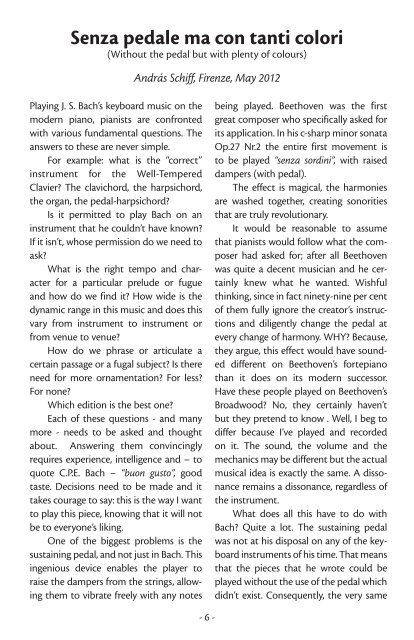Create successful ePaper yourself
Turn your PDF publications into a flip-book with our unique Google optimized e-Paper software.
Senza pedale ma con tanti colori<br />
(Without the pedal but with plenty of colours)<br />
Playing J. S. Bach’s keyboard music on the<br />
modern piano, pianists are confronted<br />
with various fundamental questions. The<br />
answers to these are never simple.<br />
For example: what is the “correct”<br />
instrument for the Well-Tempered<br />
Clavier? The clavichord, the harpsichord,<br />
the organ, the pedal-harpsichord?<br />
Is it permitted to play Bach on an<br />
instrument that he couldn’t have known?<br />
If it isn’t, whose permission do we need to<br />
ask?<br />
What is the right tempo and character<br />
for a particular prelude or fugue<br />
and how do we find it? How wide is the<br />
dynamic range in this music and does this<br />
vary from instrument to instrument or<br />
from venue to venue?<br />
How do we phrase or articulate a<br />
certain passage or a fugal subject? Is there<br />
need for more ornamentation? For less?<br />
For none?<br />
Which edition is the best one?<br />
Each of these questions - and many<br />
more - needs to be asked and thought<br />
about. Answering them convincingly<br />
requires experience, intelligence and – to<br />
quote C.P.E. Bach – “buon gusto”, good<br />
taste. Decisions need to be made and it<br />
takes courage to say: this is the way I want<br />
to play this piece, knowing that it will not<br />
be to everyone’s liking.<br />
One of the biggest problems is the<br />
sustaining pedal, and not just in Bach. This<br />
ingenious device enables the player to<br />
raise the dampers from the strings, allowing<br />
them to vibrate freely with any notes<br />
András Schiff, Firenze, May 2012<br />
- 6 -<br />
being played. Beethoven was the first<br />
great composer who specifically asked for<br />
its application. In his c-sharp minor sonata<br />
Op.27 Nr.2 the entire first movement is<br />
to be played “senza sordini”, with raised<br />
dampers (with pedal).<br />
The effect is magical, the harmonies<br />
are washed together, creating sonorities<br />
that are truly revolutionary.<br />
It would be reasonable to assume<br />
that pianists would follow what the composer<br />
had asked for; after all Beethoven<br />
was quite a decent musician and he certainly<br />
knew what he wanted. Wishful<br />
thinking, since in fact ninety-nine per cent<br />
of them fully ignore the creator’s instructions<br />
and diligently change the pedal at<br />
every change of harmony. WHY? Because,<br />
they argue, this effect would have sounded<br />
different on Beethoven’s fortepiano<br />
than it does on its modern successor.<br />
Have these people played on Beethoven’s<br />
Broadwood? No, they certainly haven’t<br />
but they pretend to know . Well, I beg to<br />
differ because I’ve played and recorded<br />
on it. The sound, the volume and the<br />
mechanics may be different but the actual<br />
musical idea is exactly the same. A dissonance<br />
remains a dissonance, regardless of<br />
the instrument.<br />
What does all this have to do with<br />
Bach? Quite a lot. The sustaining pedal<br />
was not at his disposal on any of the keyboard<br />
instruments of his time. That means<br />
that the pieces that he wrote could be<br />
played without the use of the pedal which<br />
didn’t exist. Consequently, the very same


